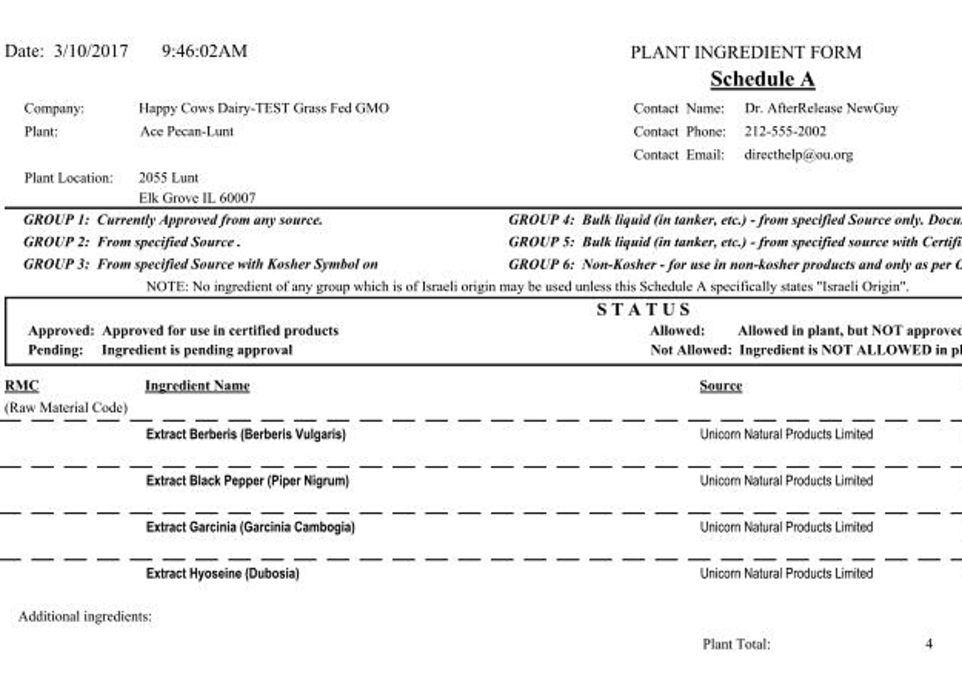How to Avoid Costly OU Symbol Labeling Errors
We al make mistakes. If you can follow these basic steps your kosher program will run smoothly and you will avoid errors that can be costly in time and reputation.
Here are a few tips to ensure your company’s packaging material is correct and in compliance.
-
- Make sure you get the purchasing department and receiving department are involved with the kosher program, and they have access to the schedule A (list of approved ingredients).
Not all ingredients are created equal. One version of vegetable oil from the Ajax company may come with kosher certification, while the different version may not have kosher certification. Certainly, a change in supply can result in a serious non-kosher situation. - Coordinate and communicate with all departments involved in the kosher program.
The sales department can offer kosher to potential private label customers; however, the customer can only use the OU symbol if a private label agreement (PLA) is signed. A PLA is a three-way licensing agreement between the OU, the manufacturer, and the distributor. Until this is signed, the private label customer may not use the OU. - The graphics department should have access to the schedule B (list of approved products), and only include the kosher symbol when the products have been certified or authorized.
Remember, plants are supervised and inspected, but certification is on a product by product basis. Even if your crackers are certified for your own company, the OU cannot be used for a private label customer until the PLA is signed and the products are added to the schedule B. More importantly, the absence of the kosher symbol should be verified when it has not been authorized or for non-certified and non-kosher products. Many mislabeled products are a result of mock-ups, where the original contained an OU symbol.Some plants which produce kosher (brand A), and non-kosher (brand B), typical in salad dressing and soup plants, should make sure to produce the OU certified version when the line is in the kosher mode.
- Make sure you get the purchasing department and receiving department are involved with the kosher program, and they have access to the schedule A (list of approved ingredients).
Working With the Kosher from Schedule A
The Schedule A is a rider to the kosher contract, and is the mutually-agreed-upon roster of materials approved for kosher production. This document lists the label name, brand name, specific source and kosher certification agency of each approved raw material—among other important kosher specs.
If the receiving department pushes through a raw material with the wrong source, or lacking any of the kosher specifications mentioned on Schedule A, it could find its way into finished product. These errors are usually caught in time. But if an unapproved RM finds its way into finished product packaged with a OU Kosher symbol—it could create a kosher-consumer concern.
The above is a snippet of a Schedule A, to which purchasing and receiving departments refer to meet kosher specifications. As they scan the document from left to right, they are prompted to ask the following questions:
- Does the ingredient name on the incoming container match the name printed here?
- Does the distributor info on the container match this specific source?
- Is this container OU-certified, or whichever agency is mentioned in that column.
- Which ‘group’ of ingredients is it in? (See “GROUP DEFINITIONS” along the top.) Is it in ‘Group 3’ (and will need to show the kosher symbol on the container) or ‘Group 4’ (and shipped in tankers, requiring an added, kosher tanker cert?)
Pareve Dairy or Meat
It’s very important to review with this document when preparing formulas—especially the ‘D/P/M’ column. This column indicates the all-important dairy/pareve status. Products that will bear a plain OU must be processed as pareve/non-dairy, while those with an OU-D symbol must not. A glance at Schedule A during formula preparation will confirm that no ‘D’ (dairy-status) ingredients find their way into a pareve formula.
Companies operating ‘mixed’ (kosher/non-kosher, or kosher-dairy/kosher-pareve) plants will need to confirm that any products to be marked with a plain-OU symbol are made in kosher-pareve mode, while those with the OU-D symbol are produced in kosher-dairy mode. Kosher agencies’ field rabbis monitor production matrixes to document this—and if an OU-pareve product were produced in dairy mode, a kosher concern would emerge.
Using Schedule B
But far from the production line, the graphics department, too, will need to keep tabs on kosher docs. They would need to treat kosher symbols with the same sensitivity with which they’re trained to regard other professional icons—as protected trademarks which require confirmation prior to usage. Is the product kosher-certified? And if so with other brands, is this particular (new) brand kosher-certified? To address these concerns, the graphics department might familiarize themselves with another important document—the Schedule B.
Here, too, a glance at Schedule B provides a brief list of OU Kosher specifications with which to reckon when designing product labels. Is a product certified at all? The above selection indicates that it’s “terminated,” not a candidate for kosher-labeling. Do we use the plain-OU jpg, or the OU-D? A glance at Schedule B will confirm which symbol to employ.
In the earlier Mega-Mart tale, the Sweet-But-Good graphics folks overlooked the errant symbol printed on the graphic. Those staffers could have eyeballed that graphic with the same care as film that features other trademarks. Fortunately, the story had a happy ending. The kosher symbol was depicted on the jpg of the kosher, though no-longer-certified, orange-flavored SKU, deemed acceptable by the YIK, after the fact. And the story was a learning experience for all those involved in kosher labeling at Sweet-But-Good: to monitor kosher compliance from raw material to finished, labeled product.
Rabbi David Arfa serves as OU Kosher rabbinic coordinator for a roster of chemical and botanical companies. He received his rabbinic training at seminaries in Manhattan and Brooklyn, where he now lives with his family.




